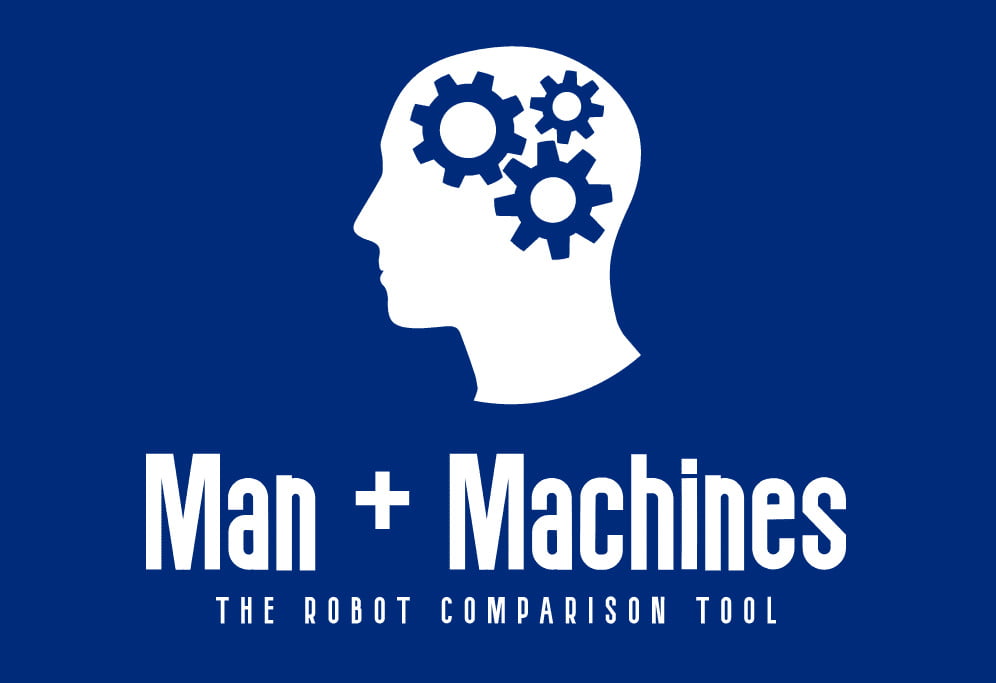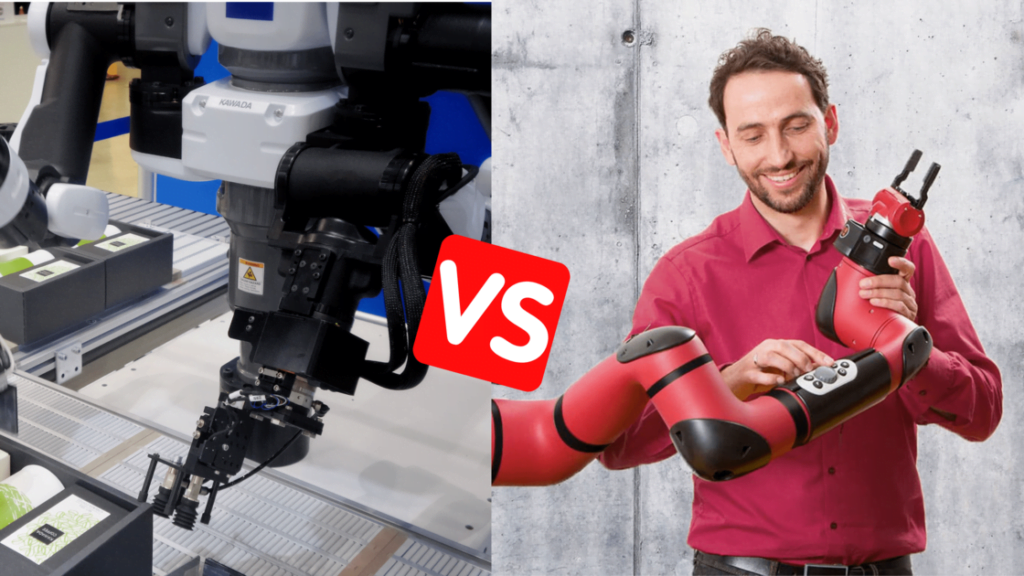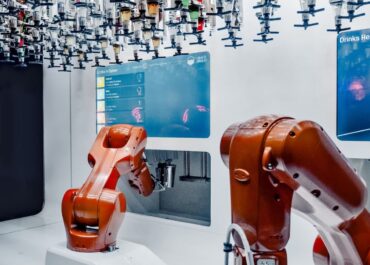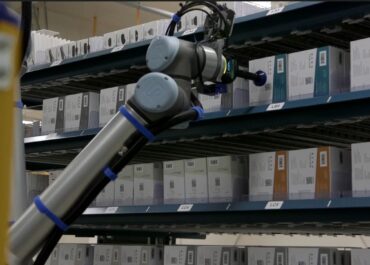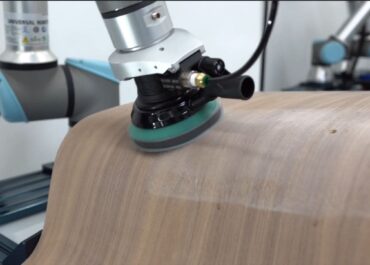Since the 60s, factories have adopted robots to expand their workforce in multiple ways. They increased their productivity in repetitive tasks and handled extreme working conditions.
As collaborative robots (cobots) are redefining the market, manufacturers find themselves with growing alternatives to standard industrial robots.
Especially for industrial SMEs, cobots are safer, cheaper, and easy to set up in new production settings. They make employees’ work better by working alongside them.
But that doesn’t mean industrial robots are less relevant for your specific applications. So which choice to make?
Here’s what these new robots can do, how they compare to industrial robots, and how you can make your buying decision.
What are industrial robots?

Industrial robots are mechanical machines designed to perform tasks in dangerous or inaccessible environments, such as in the metalwork or automotive industry. They emerged in the post-WW2 world, when factories suffered from strong labor shortages and manufacturers needed to strongly invest in their production lines.
In the United States, inventor George Devol designed in 1961 the first industrial robot, which was set up in General Motors’ factories. Called Unimate, this robot was driven by vacuum tubes and was aimed at transporting and welding dangerous die castings. Later on, European and Japanese competitors replicated this invention in their respective markets. For example, Kawasaki-Unimate 2000, the first Japanese computer-controlled robot, was first used in 1968.
The market has since grown year by year thanks to an expanding network of robotic manufacturers and distributors. In our closer time, there was a record of 2.7 million industrial robots operating in factories around the world, according to the International Federation of Robots 2020 annual report. And about 40% of industrial robots are used in the automotive industry.
Current industrial robots come in a wide variety of sizes and shapes. There are usually three types of robots: SCARA, cartesian, and articulated robots.
SCARA robots (or 2-axis robots) have only two degrees of freedom (DOF) and can move in only one axis at a time. That makes them really fast, accurate, and easy to program. But their limited capabilities also restrict their common applications (material handling and assembly operations).
Cartesian robots have 3 DOF, making them ideal for operations that require multiple movements in tight spaces. They are cheaper, operate various applications with incredible, and only use the minimal space they need to function. The only downside, they require more complex programming.
Articulated robots are defined by the number of degrees of freedom of their arm. From 1 to 10 points of axis, they can grasp items in any direction and can move around any obstacle. However, their arms make them more expansive and slower than other traditional robots.
What are cobots, and how can they help you ?

After decades of automation, robots had made industries more productive, but they were still limited to their work area and closed constitution. Workers couldn’t easily reach them to help and reprogram them, while robots couldn’t handle more flexible and evolving processes.
In the early 1990s, a group of engineers, mathematicians, and computer scientists, started to think about robots that are safer, smarter, and more sensitive. They wanted to make a robotic hand that could smoothly manipulate objects, like humans. But they had two big problems. First, how do you make a robot hand move like a person’s? Second, how do you make a robot feel like a person?
Researchers Michael Peshkin and J. Edward Colgate from Northwestern University came up with a new kind of flexible robot to relieve workers in the General Motor Manufacturing plants from exhausting applications. Even with automated assembly lines, these employees still had to lift heavy loads all day long. Peshkin and Colgate designed an intelligent winch system that lifted loads by detecting movement intents. Workers had to put minimal muscular effort to carry any object efficiently.
These strength-augmenting devices have since been coined in the industries as “collaborative robots”. Seeing their potential, forward-thinking companies like Universal Robot, Kuka and Rethink Robotis have put on the market the first commercially-sustainable cobot models.
As they have been cheaper and lightweight alternatives to articulated robots, they have become greatly popular in industries like automotive, electronics, logistics, and workshops. They are now used to working alongside humans in hazardous or repetitive tasks; like welding or palletizing.
The latest models from companies like ABB, Franka Emika and Dobots are betting to sell them to small and medium industries thanks to economically-optimized design and ease of use. They feature more and more advanced sensing capabilities to sense their surroundings, prevent collisions and increase the safety of humans. The best cobots today are also easy to use, so that, in many cases, workers don’t even need an engineering degree to run them.
SMEs can now access low-cost automation solutions, which could set the manufacturing industries through deep and ever-lasting changes.
The main differences between robots and cobots

To emphasize the differences between robot and cobot, the abbreviation “cobot” was coined to insist on the collaborative nature of those devices.
While a robot performs a task without human control, a cobot performs tasks in collaboration with human workers. The cobot differs from industrial robots in the way that operators can work safely close to it without fences. That opens many possibilities, like being able to hand-guide its movements or to work in tandem.
However, the comparison between cobot and robot is broader. Here are the main points of difference between robot and cobots :
Flexibility
A cobot’s main difference over an industrial robot is flexibility. Their lightweight design makes them easy to deploy, while they are fast and easy to program. As a result, they can quite quickly adapt to line changes and multiple part shapes. In contrast, traditional robots are heavy, hard to move, and require complex programming, so they are set up for one and never-changing task.
Accessibility
Collaborative robots also stand out for their cost and accessibility, especially for modest manufacturing businesses. Cobots help improves the productivity of SME’s workers by handling precise tasks at a low cost. Workers can deploy and teach cobots their work without external help. They are also more easily accepted among workers, as they feel they are more an ally of their work than a threat to their job. They benefit from them to improve their work condition and satisfaction. So they are easy to implement on existing processes.
Industrial robots, on the other hand, are quite expensive to purchase and require long and energy-intensive integration processes. As a consequence, SMEs can’t really afford them and can’t expect decent ROI from their investments.
Safety
Collaborative robot’s main advantages are also about safety. Besides their lightweight and design, they provide high-end sensing features to prevent, detect and avoid collisions. That includes safe stop systems, accurate force sensing, and space-delimitation features. Those features are rarely included in standard industrial robots, since they work in closed working cells.
Sensing capabilities
Standard Industrial robots hardly feature other perception capabilities than vision. A cobot, by contrast, can rely on a variety of sensing technologies. It can sense force and motion provided by workers, and can support a wide range of high-end vision end-effectors. On the one hand, force and torque sensors enable them to adapt their movements during changing tasks. For example, during the deburring process, the cobot can change its direction of movement. During the polishing process, the cobot can rotate its brush head.
On the other hand, vision end-effectors can help cobots detect and select changing parts on moving conveyor belts. Workers can quite easily train their cobots to handle high mix part feeding flow.
Cobot or Robot: which one to choose?

Now that you know the main differences between industrial robots and cobot, how do you make up your mind?
You can consider these 5 factors to know which type of robot can help you the most in your application :
1. Industrial requirements :
As a plant manager, you have goals and KPIs to reach to make your business sustainable. Those should be the first things in your mind when making your buying decision.
The first requirement is about performance and cycle time.
On an equal footing, industrial robots provide unmatched technical specifications against collaborative robots. They are often faster, more accurate, powerful, and reach further. They thus better improve your cycle times and throughput rate. But collaborative robot models are providing higher and higher performance.
The second requirement is production volume and part variation.
Industrial robots are made to perform in high-volume manufacturing processes with low variations. They are not easy to reprogram and redeploy on new cell settings and part configurations.
Cobots, on the other hand, can flexibly adapt to part variations. You can set different programs for your different kinds of parts, and deliberately switch from one to the other. You can also place your cobot on a mobile platform to move it from one cell to another. So cobots are a perfect fit for high-mix, low-volume manufacturing processes.
Another requirement is the size, weight, and location of your parts.
Industrial robots are made to lift and handle heavy and large parts, which can be sometimes hard to reach. Meanwhile, collaborative robots thrive with low and medium part specifications and depend on their respective reach capabilities.
2. Type of application :
Industrial robots are still the best options when it comes to material removal and assembly applications, while collaborative robots show impressive results in finishing, machine tending, pick and place, and quality control applications.
Depending on your application, choose wisely which type performs the best.
3. Work settings
Do you have a huge manufacturing floor, or can you allocate only a small working cell to your robot? As they need fences for safety reasons, industrial robots can take up a lot of space. In contrast, collaborative robots safely work alongside your employees, so they can save you a lot of space and facilitate your worker’s movements.
4. Human resources
Do you have automation-expert engineers, or are you short of programming talents? That might greatly matter, as collaborative robots don’t need specific qualifications to code them, while industrial robots require more technical skills.
5. Automation goal :
What’s your main goal? Improving throughput, cycle time, turnaround time, freeing up workers from tedious tasks, improving their safety on the floor, maximizing output quality, or minimizing waste…?
All-in-all, collaborative robots can improve your worker experience while providing greater performance and quality. Industrial robots exclusively aim at augmenting your speed and quantity of output. Your final decision will depend on what you want to improve on your manufacturing line.
You now have everything in your hands to make a mindful decision. Cobot or robot, it’s all up to you!
